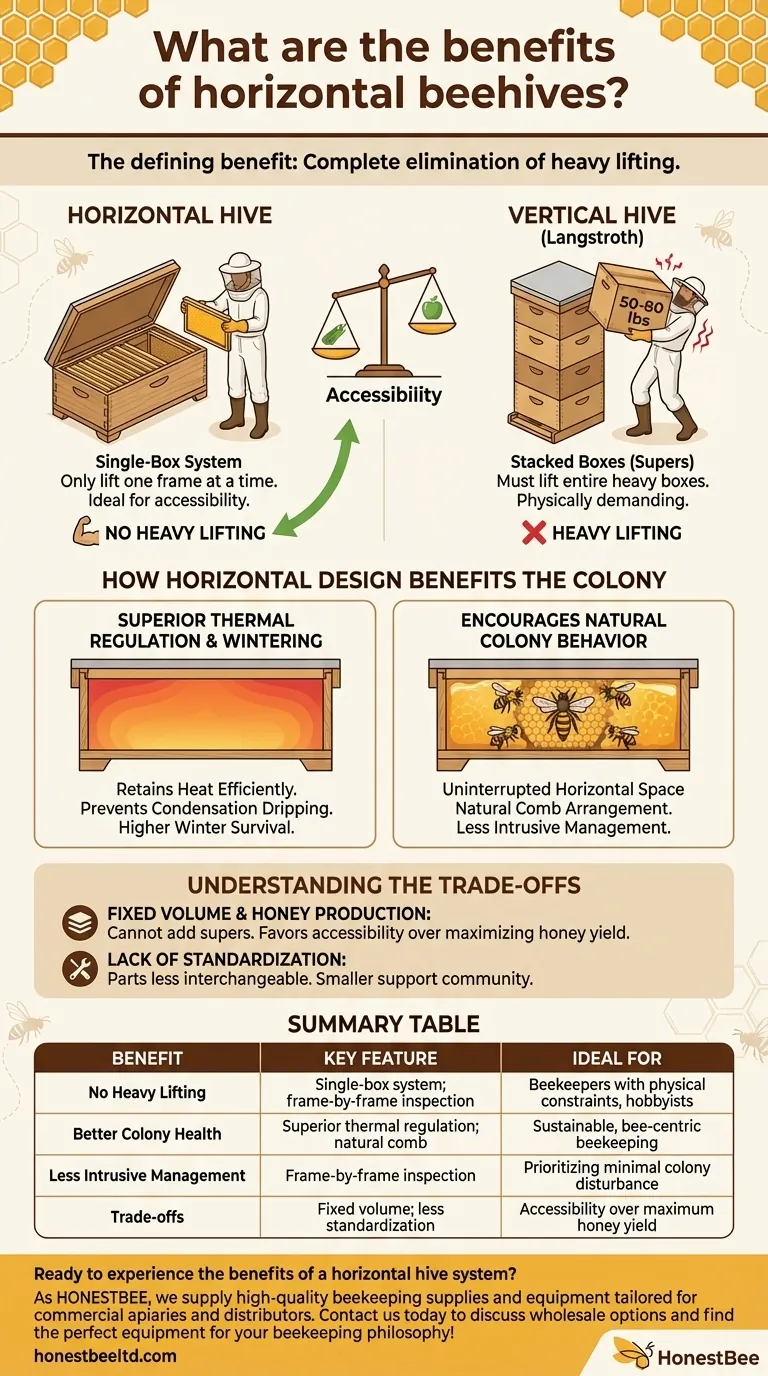The defining benefit of a horizontal beehive is the complete elimination of heavy lifting. Unlike vertically stacked hives, a horizontal hive consists of a single, long box where all management occurs, meaning the beekeeper only ever needs to lift one frame at a time, never an entire 50-pound box of honey.
The choice between a horizontal and vertical hive is not just about physical ease; it's a decision between two distinct philosophies of beekeeping. Horizontal hives favor a less intrusive, colony-centric approach, while vertical hives are optimized for modularity and honey production.
The Core Advantage: No Heavy Lifting
The most compelling reason beekeepers choose horizontal hives is for accessibility and ease of management. This design fundamentally changes the physical demands of the hobby.
A Single-Box System
A horizontal hive, such as a Top-Bar or Layens hive, contains the entire colony—brood, pollen, and honey—in one long box. You never add or remove heavy boxes (called "supers") as the colony expands or during honey harvest.
This contrasts sharply with the standard vertical Langstroth hive, which requires lifting and rearranging boxes that can weigh 50-80 pounds each.
Frame-by-Frame Inspection
All inspections and manipulations happen by removing one frame at a time. This makes the process significantly less strenuous and accessible to people with back problems, limited strength, or other physical constraints.
How Horizontal Design Benefits the Colony
The shape of the hive doesn't just benefit the beekeeper; it can also create a more stable and natural environment for the bees.
Superior Thermal Regulation and Wintering
A well-insulated horizontal hive mimics the thermal dynamics of a natural log. The single, large cavity has less surface area relative to its volume compared to a stack of smaller boxes, which helps the colony retain heat more efficiently in winter.
This design also helps prevent condensation from dripping down onto the cluster, a major cause of winter colony death. As a result, colonies in horizontal hives often have higher winter survival rates.
Encourages Natural Colony Behavior
The uninterrupted horizontal space allows the queen to lay eggs in a wide, natural pattern without being constrained by the "bee space" between stacked boxes.
The colony can organize its resources more naturally, typically with the brood nest in the center and honey stores expanding out to the sides, which is how they would arrange a hollow tree.
Less Intrusive Management
Because you can inspect the hive frame by frame from one end, it's possible to check on the colony's progress without disturbing the entire brood nest. This reduces stress on the colony during routine inspections.
Understanding the Trade-offs
While beneficial, horizontal hives are not the default choice for a reason. Their design comes with significant trade-offs compared to the industry-standard Langstroth hive.
Fixed Volume and Honey Production
The biggest limitation is the hive's fixed volume. You cannot add more supers to take advantage of a strong nectar flow. For this reason, vertical Langstroth hives are almost always favored for maximizing honey production.
Lack of Standardization
The Langstroth system is highly standardized. Parts from different manufacturers are almost always interchangeable. Horizontal hives, especially designs like the Layens, often have unique frame sizes and components that are harder to find and more expensive.
Smaller Community and Support
The vast majority of beekeepers, books, and online resources are focused on the Langstroth hive. Finding experienced mentors, troubleshooting advice, or local support for horizontal hive management can be more challenging.
Making the Right Choice for Your Goal
Your beekeeping goals should dictate your choice of equipment. There is no single "best" hive, only the best hive for you.
- If your primary focus is accessibility and a natural, less-intensive approach: The horizontal hive's no-lift design and colony-centric benefits make it an outstanding choice.
- If your primary focus is maximizing honey production and using readily available equipment: The vertical Langstroth hive remains the industry standard for its modularity and widespread support.
Ultimately, choosing a hive is about aligning the equipment with your physical abilities and your personal beekeeping philosophy.
Summary Table:
| Benefit | Key Feature | Ideal For |
|---|---|---|
| No Heavy Lifting | Single-box system; inspect one frame at a time | Beekeepers with physical constraints, hobbyists |
| Better Colony Health | Superior thermal regulation; natural comb arrangement | Sustainable, bee-centric beekeeping |
| Less Intrusive Management | Frame-by-frame inspection from one end | Beekeepers prioritizing minimal colony disturbance |
| Trade-offs | Fixed volume; less standardization | Best for accessibility over maximum honey yield |
Ready to experience the benefits of a horizontal hive system? As HONESTBEE, we supply high-quality beekeeping supplies and equipment tailored for commercial apiaries and distributors. Our horizontal hive solutions are designed to enhance your operation's efficiency and bee welfare. Contact us today to discuss wholesale options and find the perfect equipment for your beekeeping philosophy!
Visual Guide

Related Products
- Long Langstroth Style Horizontal Top Bar Hive for Wholesale
- HONESTBEE Professional Long Handled Hive Tool with Precision Cutting Blade
- Top Bar Beehive for Beekeeping Wholesales Kenya Top Bar Hive
- HONESTBEE Professional Multi-Functional Hive Tool with Ergonomic Wood Handle
- HONESTBEE Advanced Ergonomic Stainless Steel Hive Tool for Beekeeping
People Also Ask
- What are the box management requirements for a top bar hive vs. Langstroth? Choose Your Hive Strategy
- What are the benefits of a top bar hive? A Natural, Low-Impact Approach to Beekeeping
- How does the top bar hive help control varroa mites? A Natural Approach to Mite Management
- What are the benefits of the top bar hive? A Guide to Ergonomic, Natural Beekeeping
- What are the most popular types of hives besides the Langstroth? Top Bar & Horizontal Hives Explained



















